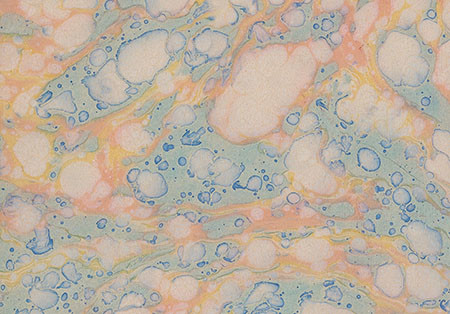Marbled endpapers, like these that line the covers of a twentieth-century fine-press edition of Keats’s letters, sometimes can stand as works of art in their own right.
The simplest paper marble pattern is intended to evoke the veining of natural marble. The designs, which include stone, feather, palm, peacock and placard patterns (and many others as well), can be as intricate as they are colorful, though achieving a striking effect, like the watercolor stone pattern shown above, is not as easy as sounds.
Paper marblers float paints – acrylic, oil, watercolor – on the surface of viscous water, typically water that has been thickened by carrageen, and then arrange the paints into a pattern using brushes, combs, droppers, styli and other tools. When the design is finished to satisfaction, paper treated with a binding agent, such as alum, is pulled through the tray of water in a smooth motion that transfers the floating paints to the paper’s surface. The paper, or textile, is then rinsed and line dried.
Hand-marbled paper used as the decorative lining papers of books reached an apex of popularity and splendor in the eighteenth century, particularly among European bookbinders. Marbled designs can also be found on the fore-edges and paper wrappers of books, and occasionally on the leather of decorative binding covers.
The Letters of John Keats to Fanny Brawne was produced by the Halcyon Press, a Dutch firm established by the polymath Alexandre A. M. Stols in 1927, which published limited-edition works of the English and European literati. This volume is part of the Beinecke’s remarkable Frank Altschul Collection of French illustrated books and is one of 31 copies, printed on Charles I handmade paper.
